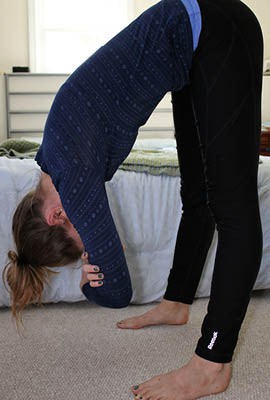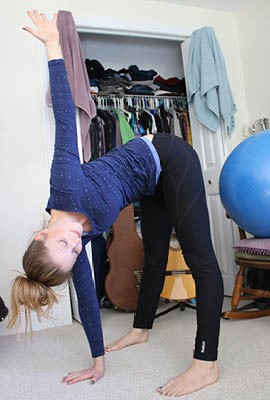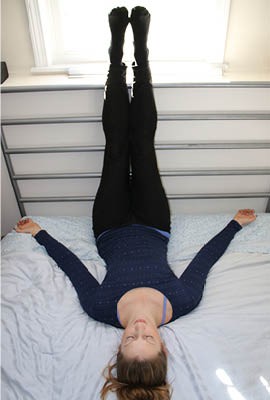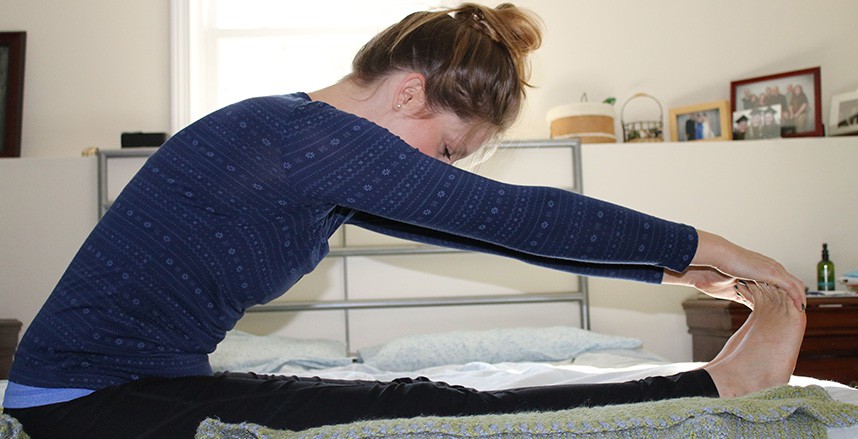Sleep is vital for concentration, immune function, and mental, emotional, and physical health. But research shows that high school students aren’t getting enough of it. In fact, only about 30 percent of teens get the recommended 8-10 hours of sleep per night, according to the Centers for Disease Control and Prevention.
With busy schedules, early school start times, and a lot on their minds, it can be difficult for students to relax in time for bed. Our interactive feature article “How to stretch your way to better sleep” provides tutorials for simple yoga poses and relaxation exercises to help students wind-down. For example:
 Forward bend  Gentle spinal twist  Legs-up-the-wall pose |
Meditation and mindfulness exercises are also a great way for students to calm their active minds at night. Check out these guided meditations from Koru Mindfulness, an evidence-based mindfulness program developed by Dr. Holly Rogers at Duke University.
Student reactions to the article
Eighty-eight percent of students surveyed said they’d read the article and learned something from it, according to a Student Health 101 poll.
Here’s what students had to say:
“High school is stressful, especially with all the homework assigned every night. I am currently in the process of trying out for the soccer team. I barely have enough time between homework, school, sports and friends to focus on sleep. I will apply the stretching for a better sleep in my daily life.”
—Student, New Trier Township High School
“I love the yoga article and tried out some moves myself. It really helped me feel more relaxed and calm.”
—Student, Singapore American School
“Next time I am anxious before bed, I will try to do the relaxing yoga poses.”
—Student, New Trier Township High School
“[I learned] how stretching and a routine helps for a consistent sleep.”
—Student, Concord Carlisle High School
Bedtime routines
A nightly yoga routine is just one way to engage students in thinking about their sleep. Whether students choose gentle yoga, mindfulness-based practices, or other relaxation exercises, research shows that consistent bedtimes and consistent bedtime routines can help improve sleep.
Encourage students to try these sleep tips:
- Aim to go to bed and wake up around the same time each day. This sets your body’s internal clock.
- Dim the lights and put electronics away at least an hour before bed to signal to your brain that it’s time to get sleepy.
- Use a sleep mask and earplugs to block out light and sound at night.
- Open the blinds to let bright light in in the morning.
- Avoid caffeine after 3 pm (or earlier if you’re sensitive to its effects).
- Try to finish up homework at least an hour before bed so your brain can unwind.
- Keep your bed a place for sleeping. Sit somewhere else when doing homework, watching TV, playing computer games, etc.
- Use a traditional alarm clock to wake up instead of your phone.
- Keep your phone charging in another room or far away from your bed. This will limit the temptation to use it at night.
Sources
Carlton-Smith, A. (2015, March 1). How to stretch your way to better sleep. Student Health 101, 2(13).
The Center for Koru Mindfulness. (2016). Free guided meditations. Retrieved from http://korumindfulness.org/guided-meditations/
National Sleep Foundation. (2000). Adolescent sleep needs and patterns: Research report and resource guide. Retrieved from https://sleepfoundation.org/sites/default/files/sleep_and_teens_report1.pdf
Perfect, M., & Smith, B. (2016). Hypnotic relaxation and yoga to improve sleep and school functioning. International Journal of School & Educational Psychology, 4(1), 43-51.

